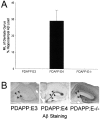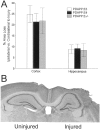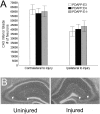Apolipoprotein E4 influences amyloid deposition but not cell loss after traumatic brain injury in a mouse model of Alzheimer's disease
- PMID: 12451108
- PMCID: PMC6758744
- DOI: 10.1523/JNEUROSCI.22-23-10083.2002
Apolipoprotein E4 influences amyloid deposition but not cell loss after traumatic brain injury in a mouse model of Alzheimer's disease
Abstract
The epsilon4 allele of apolipoprotein E (APOE) and traumatic brain injury (TBI) are both risk factors for the development of Alzheimer's disease (AD). These factors may act synergistically, in that APOE4+ individuals are more likely to develop dementia after TBI. Because the mechanism underlying these effects is unclear, we questioned whether APOE4 and TBI interact either through effects on amyloid-beta (Abeta) or by enhancing cell death/tissue injury. We assessed the effects of TBI in PDAPP mice (transgenic mice that develop AD-like pathology) expressing human APOE3 (PDAPP:E3), human APOE4 (PDAPP:E4), or no APOE (PDAPP:E-/-). Mice were subjected to a unilateral cortical impact injury at 9-10 months of age and allowed to survive for 3 months. Abeta load, hippocampal/cortical volumes, and hippocampal CA3 cell loss were quantified using stereological methods. All of the groups contained mice with Abeta-immunoreactive deposits (56% PDAPP:E4, 20% PDAPP:E3, 75% PDAPP:E-/-), but thioflavine-S-positive Abeta (amyloid) was present only in the molecular layer of the dentate gyrus in the PDAPP:E4 mice (44%). In contrast, our previous studies showed that in the absence of TBI, PDAPP:E3 and PDAPP:E4 mice have little to no Abeta deposition at this age. After TBI, all of the Abeta deposits present in PDAPP:E3 and PDAPP:E-/- mice were diffuse plaques. In contrast to the effect of APOE4 on amyloid, PDAPP:E3, PDAPP:E4, and PDAPP:E-/- mice did not differ in the amount of brain tissue or cell loss. These data support the hypothesis that APOE4 influences the neurodegenerative cascade after TBI via an effect on Abeta.
Figures



Similar articles
-
Modulation of Alzheimer-like synaptic and cholinergic deficits in transgenic mice by human apolipoprotein E depends on isoform, aging, and overexpression of amyloid beta peptides but not on plaque formation.J Neurosci. 2002 Dec 15;22(24):10539-48. doi: 10.1523/JNEUROSCI.22-24-10539.2002. J Neurosci. 2002. PMID: 12486146 Free PMC article.
-
Human apolipoprotein E4 alters the amyloid-beta 40:42 ratio and promotes the formation of cerebral amyloid angiopathy in an amyloid precursor protein transgenic model.J Neurosci. 2005 Mar 16;25(11):2803-10. doi: 10.1523/JNEUROSCI.5170-04.2005. J Neurosci. 2005. PMID: 15772340 Free PMC article.
-
Traumatic brain injury in young, amyloid-beta peptide overexpressing transgenic mice induces marked ipsilateral hippocampal atrophy and diminished Abeta deposition during aging.J Comp Neurol. 1999 Aug 30;411(3):390-8. J Comp Neurol. 1999. PMID: 10413774
-
Apolipoprotein E dose-dependent modulation of beta-amyloid deposition in a transgenic mouse model of Alzheimer's disease.J Mol Neurosci. 2004;23(3):255-62. doi: 10.1385/JMN:23:3:255. J Mol Neurosci. 2004. PMID: 15181254 Review.
-
Apolipoprotein E isoforms in Alzheimer's disease pathology and etiology.Microsc Res Tech. 2000 Aug 15;50(4):278-81. doi: 10.1002/1097-0029(20000815)50:4<278::AID-JEMT5>3.0.CO;2-T. Microsc Res Tech. 2000. PMID: 10936880 Review.
Cited by
-
Missense Mutation of Brain Derived Neurotrophic Factor (BDNF) Alters Neurocognitive Performance in Patients with Mild Traumatic Brain Injury: A Longitudinal Study.PLoS One. 2016 Jul 20;11(7):e0158838. doi: 10.1371/journal.pone.0158838. eCollection 2016. PLoS One. 2016. PMID: 27438599 Free PMC article.
-
Long-Term Effects of Traumatic Brain Injury in a Mouse Model of Alzheimer's Disease.J Alzheimers Dis. 2019;72(1):161-180. doi: 10.3233/JAD-190572. J Alzheimers Dis. 2019. PMID: 31561367 Free PMC article.
-
Epidemiology of Alzheimer disease.Cold Spring Harb Perspect Med. 2012 Aug 1;2(8):a006239. doi: 10.1101/cshperspect.a006239. Cold Spring Harb Perspect Med. 2012. PMID: 22908189 Free PMC article. Review.
-
The neuropathology of traumatic brain injury.Handb Clin Neurol. 2015;127:45-66. doi: 10.1016/B978-0-444-52892-6.00004-0. Handb Clin Neurol. 2015. PMID: 25702209 Free PMC article. Review.
-
Traumatic brain injury: cause or risk of Alzheimer's disease? A review of experimental studies.J Neural Transm (Vienna). 2005 Nov;112(11):1547-64. doi: 10.1007/s00702-005-0326-0. Epub 2005 Jun 15. J Neural Transm (Vienna). 2005. PMID: 15959838 Review.
References
-
- Bales KR, Verina T, Dodel RC, Du Y, Altstiel L, Bender M, Hyslop P, Johnstone EM, Little SP, Cummins DJ, Piccardo P, Ghetti B, Paul SM. Lack of apolipoprotein E dramatically reduces amyloid β-peptide deposition. Nat Genet. 1997;17:263–264. - PubMed
-
- Chen Y, Lomnitski L, Michaelson DM, Shohami E. Motor and cognitive deficits in apolipoprotein E-deficient mice after closed head injury. Neuroscience. 1997;80:1255–1262. - PubMed
-
- Crawford FC, Vanderploeg RD, Freeman MJ, Singh S, Waisman M, Michaels L, Abdullah L, Warden D, Lipsky R, Salazar A, Mullan MJ. APOE genotype influences acquisition and recall following traumatic brain injury. Neurology. 2002;58:1115–1118. - PubMed
-
- Emmerling MR, Morganti-Kossmann MC, Kossmann T, Stahel PF, Watson MD, Evans LM, Mehta PD, Spiegel K, Kuo YM, Roher AE, Raby CA. Traumatic brain injury elevates the Alzheimer's amyloid peptide Aβ42 in human CSF: a possible role for nerve cell injury. Ann NY Acad Sci. 2000;903:118–122. - PubMed
Publication types
MeSH terms
Substances
Grants and funding
LinkOut - more resources
Full Text Sources
Other Literature Sources
Medical
Molecular Biology Databases
Miscellaneous
